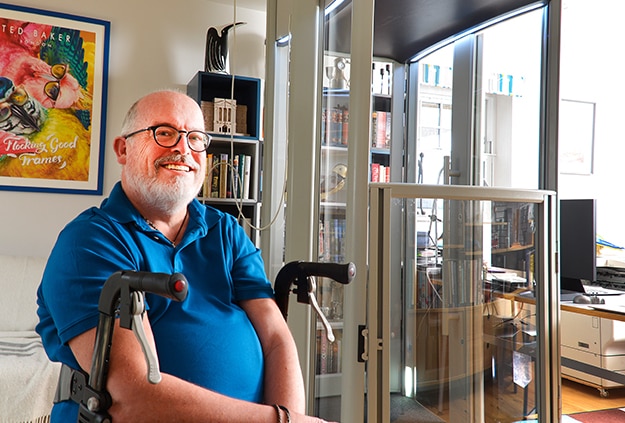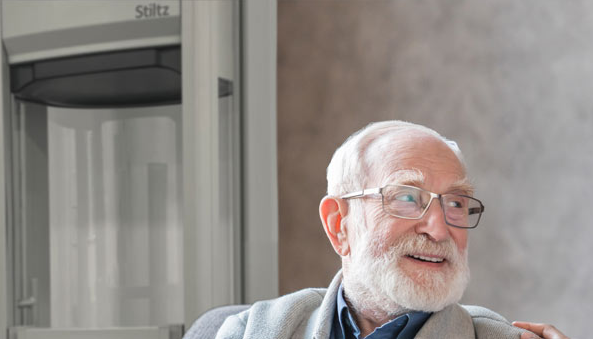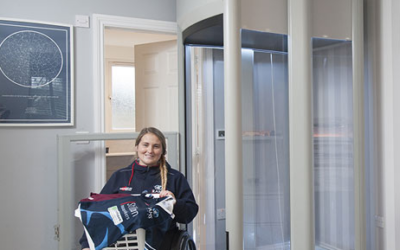Correcting misconceptions about home lifts
Written by Stuart Barrow, Occupational Therapist
To help healthcare professionals achieve better client outcomes, Occupational Therapist Stuart Barrow covers the most common misunderstandings about domestic home lifts – from fire safety to Disabled Facilities Grants.
- Domestic home lifts do not work for people with dementia
Domestic home lifts are completely safe for people with dementia. A suitable risk assessment must of course be carried out as everyone with dementia should be individually assessed, but a diagnosis should never mean a product is automatically discounted. Home lifts allow safe access between floors and have a range of in-built safety features such as a full-height light curtain which acts as a sensor to ensure nothing crosses into or out of the lift as it travels. The lifts also have safety sensors fitted above and below the car which detect obstructions and smoothly but quickly stop the lift. Home lifts can also be customised to included padded surfaces for an increased level of protection.
- You can only fit one person in a domestic home lift
This is not true. Domestic home lifts are designed for two or three people to travel comfortably. More compact lifts with a smaller footprint are ideal for two people. A larger (but still compact) design accommodates a wheelchair user or three people. This lift has a larger cab design and a heavier carrying load. The lifts can also be used to carry large, heavy items between floors. Some lifts are designed to carry up to 250kg/39 stone.
- Stiltz Home Lifts aren’t safe for children and pets
Safety features ensure that domestic home lifts are completely safe for children and pets. For example, the safety pans on the top and underneath of the lift car have multiple microswitches all of which detect contact with immovable objects. The lift will stop immediately should something or someone stand on the lift car lid upstairs or below the lift as it descends. A unique light curtain also acts as an emergency stop device. Lift travel will cease immediately if the light curtain is breached. The lift car door locks automatically and will not open while the lift is travelling. Only once the lift reaches its final position will the door auto-unlock. There is also a key switch operation that allows the owner to isolate the lift if the need arises. This is commonly used when going away on holiday or when the grandchildren are around.
- Stiltz Home Lifts aren’t fireproof
Not true. All reputable home lifts will comply with full fire safety regulations, and while a fire seal is not a regulatory requirement most home lift providers will offer this feature. Look for home lifts that state they are fitted with a fire seal, which have been specifically designed to help prevent the spread of fire between two floors in a domestic property. For example, the Stiltz Trio+ Fire Seal Home Lift forms a barrier between the two floors. If the lift is parked on the lower floor, the barrier is formed by the lid of the lift which normally fills in the aperture through which the lift travels. If the lift is parked on the upper floor, the underpan of the lift forms the barrier within the metal insert in the aperture. The home lift is linked by radio signal to smoke alarms positioned on both the floors the lift operates across. If either alarm detects smoke, it will send a signal to the lift. If the lift is in its parked position either on the upper or lower floor, it will remain where it is parked in order to maintain the integrity of the fire seal.
It is important to note that a client review should take place ideally every year. This will ensure home lifts are still suitable if your client has a deteriorating condition or there are concerns about fire safety within the home in general.
- A Stiltz Home Lift isn’t suitable for multiple floors
Many home lifts can safely travel between multiple floors. For example, a Stiltz Trio + can travel up to 6 Metres, so can, in a typical UK home, usually move between three floors.
- Disabled Facilities Grant (DFG) do not include domestic home lifts
Your client can apply for a DFG for a variety of adaptations including home lifts, stairlifts, widening doors, installing ramps and improving access to rooms, heating, lighting and ventilation systems. Eligibility will depend on the household’s income and any savings. (DFG’s are not means-tested when applying for adaptations for children).
- In summary
Home lifts can be a lifeline for your clients but as with all equipment and adaptations, an assessment of individual needs and a risk assessment should be carried out to ensure suitability now and in the future. The risk assessment should be proportionate to need and ensure it considers any likely deterioration and the requirement for regular reviews.
As an Occupational Therapist, by recommending a home lift you are giving your client the independence to safely move between floors, accessing all areas of the home. Daily living activities, such as putting the children to bed and using the first-floor bathroom, can be carried out. A home lift will additionally benefit other members of the household as moving and handling risks are reduced. The need for costly carers in the home or relocation to residential care can also be eliminated.

“Home lifts allow safe access between floors and have a range of in-built safety features such as a full-height light curtain which acts as a sensor to ensure nothing crosses into or out of the lift as it travels…”







